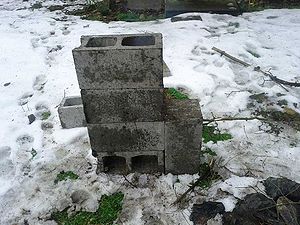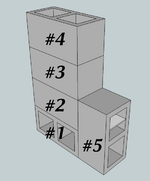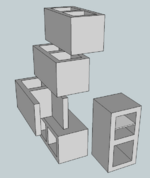Difference between revisions of "User:Hapa/Sandbox"
| (3 intermediate revisions by the same user not shown) | |||
| Line 1: | Line 1: | ||
| − | How to make a | + | How to make a rocket stove from cinder blocks |
| + | Wikipedia defines a [[wp:rocket stove | rocket stove]] as: | ||
| − | + | "A rocket stove is an innovative clean and efficient cooking stove using small diameter wood fuel which is burned in simple high-temperature combustion chamber containing an insulated vertical chimney which ensures complete combustion prior to the flames reaching the cooking surface." | |
| − | |||
| − | + | [[image:CinderBlockRocketStove.jpg|right|300px]] | |
| − | + | == What You Will Need == | |
| + | * 5 Cinder blocks | ||
| + | * A chisel | ||
| + | * A hammer | ||
| + | * A small piece of sheet metal or wire mesh | ||
| + | * Safety glasses or goggles | ||
| + | * Paper | ||
| + | * Dry branches to burn | ||
| + | * Kindling | ||
| + | * Matches or a lighter | ||
| − | + | == Chisel Out Wall == | |
| + | To make an access area for the fire chamber you must chisel out a portion of the wall on one of the cinder blocks | ||
| + | * Don your safety glasses or goggles | ||
| + | * Using the hammer and chisel carefully remove the front portion of the wall of block #2 | ||
| − | |||
| + | == Stack The Blocks == | ||
| + | [[image:CinderBlockRocketStove01.png|right|150px]][[image:CinderBlockRocketStove04.png|right|150px]] | ||
| + | * You must place the cinder blocks on firm level ground | ||
| + | * Place block #1 so that it is on it's side with the holes parallel to the ground | ||
| + | * Place block #2 on top of block #1 with the holes perpendicular to the ground | ||
| + | * Place block #3 on top of block #2 with it's holes perpendicular to the ground | ||
| + | * Place block #4 on top of block #2 with it's holes also perpendicular to the ground | ||
| + | * Place Block #5 standing on it's end so that the top hole lines up with the cut out for the fire chamber | ||
| + | * Place sheet metal or wire mesh in the top hole of block #5 so that it is in the middle of the hole parallel to the ground. | ||
| − | |||
| − | |||
| − | |||
| − | |||
| − | |||
| − | |||
| − | |||
| − | |||
| − | |||
| − | |||
| − | |||
| − | |||
| − | |||
| − | |||
| − | |||
| − | |||
| − | |||
| − | |||
| − | |||
| − | |||
| − | |||
| − | |||
| − | |||
| − | |||
| − | |||
| + | == Light It Up == | ||
| + | I found it easier to move block #5 out of the way in order to light the fire. | ||
| + | * Place some paper and small kindling in the fire chamber and light. | ||
| + | * Once you have a sustainable fire in the firebox then place block #5 back into position. | ||
| + | * Place sticks into the opening on top of the metal plate. | ||
| + | == Some Thoughts == | ||
| − | + | I built this last weekend, it only took me about 30 min. | |
| − | + | Be very careful when chiseling the cinder block, I ruined one. | |
| − | + | It was a cold day about 40F so the updraft wasn't all that great. | |
| − | + | I also didn't have very dry branches around me so I eventually resorted to some plywood strips I had lying around. | |
| − | + | Once I got a strong fire working in the chamber it worked very nice wellI was able to boil some water in about 20 min or so. | |
| − | |||
| − | |||
| − | |||
| − | |||
| − | |||
| − | |||
| − | |||
| − | |||
| − | |||
| − | |||
| − | |||
| − | |||
| − | |||
| − | |||
| − | |||
| − | |||
| − | |||
| − | |||
| − | |||
| − | |||
| − | |||
| − | |||
| − | |||
| − | |||
| − | |||
| − | |||
| − | |||
| − | |||
| − | |||
| − | |||
| − | |||
| − | |||
| − | |||
| − | |||
| − | |||
| − | |||
| − | |||
| − | |||
| − | |||
| − | |||
| − | |||
| − | |||
| − | |||
| − | |||
| − | |||
| − | |||
| − | |||
| − | |||
| − | |||
| − | |||
| − | |||
| − | |||
| − | |||
| − | |||
| − | |||
| − | |||
| − | |||
| − | |||
| − | |||
| − | |||
| − | |||
| − | |||
| − | |||
| − | |||
| − | |||
| − | |||
| − | |||
| − | |||
| − | |||
| − | |||
| − | |||
| − | |||
| − | |||
| − | |||
| − | |||
| − | |||
| − | |||
| − | |||
| − | |||
| − | |||
| − | |||
| − | |||
| − | |||
| − | |||
| − | |||
| − | |||
| − | |||
| − | |||
| − | |||
| − | |||
== Bibliography == | == Bibliography == | ||
| − | * ISBN | + | * ISBN 0966373839 |
| − | * ISBN | + | * ISBN 1903998727 |
| − | * ISBN | + | * ISBN 0966373820 |
== Amazon's Related Products == | == Amazon's Related Products == | ||
| − | * ASIN | + | * ASIN B005NKN6NK |
| − | * ASIN | + | * ASIN B004OMI7RS |
| − | * ASIN | + | * ASIN B005GQZ4O0 |
== See Also == | == See Also == | ||
| − | * How to [[ | + | * How to [[Obtain water in the wilderness]] |
| − | + | ||
| − | |||
| − | |||
| − | |||
== External Links == | == External Links == | ||
| − | * [http:// | + | * [http://www.permies.com/t/5504/stoves/Five-Block-Rocket-Stove-design Five Block RocketStove Design at permies.com] - The inspiration for this tutorial. |
| + | * [http://www.richsoil.com/rocket-stove-mass-heater.jsp | Rocket Mass Heater article at permies.com] | ||
| + | * [[wp:rocket stove | Rocket Stove on Wikipedia]] | ||
Latest revision as of 06:43, 30 January 2012
How to make a rocket stove from cinder blocks
Wikipedia defines a rocket stove as:
"A rocket stove is an innovative clean and efficient cooking stove using small diameter wood fuel which is burned in simple high-temperature combustion chamber containing an insulated vertical chimney which ensures complete combustion prior to the flames reaching the cooking surface."
Contents
What You Will Need
- 5 Cinder blocks
- A chisel
- A hammer
- A small piece of sheet metal or wire mesh
- Safety glasses or goggles
- Paper
- Dry branches to burn
- Kindling
- Matches or a lighter
Chisel Out Wall
To make an access area for the fire chamber you must chisel out a portion of the wall on one of the cinder blocks
- Don your safety glasses or goggles
- Using the hammer and chisel carefully remove the front portion of the wall of block #2
Stack The Blocks
- You must place the cinder blocks on firm level ground
- Place block #1 so that it is on it's side with the holes parallel to the ground
- Place block #2 on top of block #1 with the holes perpendicular to the ground
- Place block #3 on top of block #2 with it's holes perpendicular to the ground
- Place block #4 on top of block #2 with it's holes also perpendicular to the ground
- Place Block #5 standing on it's end so that the top hole lines up with the cut out for the fire chamber
- Place sheet metal or wire mesh in the top hole of block #5 so that it is in the middle of the hole parallel to the ground.
Light It Up
I found it easier to move block #5 out of the way in order to light the fire.
- Place some paper and small kindling in the fire chamber and light.
- Once you have a sustainable fire in the firebox then place block #5 back into position.
- Place sticks into the opening on top of the metal plate.
Some Thoughts
I built this last weekend, it only took me about 30 min. Be very careful when chiseling the cinder block, I ruined one. It was a cold day about 40F so the updraft wasn't all that great. I also didn't have very dry branches around me so I eventually resorted to some plywood strips I had lying around. Once I got a strong fire working in the chamber it worked very nice wellI was able to boil some water in about 20 min or so.
Bibliography
- ISBN 0966373839
- ISBN 1903998727
- ISBN 0966373820
Amazon's Related Products
- ASIN B005NKN6NK
- ASIN B004OMI7RS
- ASIN B005GQZ4O0
See Also
External Links
- Five Block RocketStove Design at permies.com - The inspiration for this tutorial.
- | Rocket Mass Heater article at permies.com
- Rocket Stove on Wikipedia


